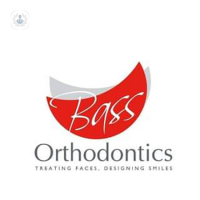What is interceptive orthodontics?
Interceptive orthodontics, also referred to as phase 1 orthodontics, is the first phase of orthodontic treatment. It entails the early diagnosis of children’s future dental problems.
It's a long term treatment that involves preparing a child’s jaw and/or teeth for future growth by using tools such as braces, aligners, and expanders.

With this early diagnosis, an orthodontist can identify potential problems:
- An underbite
- An overbite
- Crooked teeth
- A missing tooth that will never grow in to replace a baby tooth
- Crowded teeth
- Crossbite
Why is interceptive orthodontics done?
By performing interceptive orthodontics before the child’s adult teeth grow in, the risk of the teeth being extracted during corrective treatment (phase 2) is lowered.
Interceptive orthodontics isn't purely for aesthetic reasons. Having misaligned teeth can make it more difficult to properly look after oral hygiene.
What does it involve?
Some examples include:
- Jaw adjustment - If the jaw appears too small for the future adult teeth, the orthodontist may recommend a palatal expander. By doing so, the adult teeth have room to grow in without crowding and becoming crooked
- Removal of baby teeth - While not common, it can be necessary to remove a baby teeth to allow the adult teeth to grow in ant the right time.
- No treatment (during phase 1) - Treatment during phase 1 isn’t always necessary, as the orthodontist may recommend waiting until the baby teeth have fallen out and adult teeth start to grow in before beginning treatment.

How do you prepare for interceptive orthodontics?
Interceptive orthodontics is primarily a diagnostic procedure. Therefore, little to no preparation is required by the parent and child. Your orthodontist will provide you with advice concerning which treatment to start and when.
What are alternatives to this treatment?
The alternative to interceptive orthodontics is to wait until the child needs corrective treatment once the adult teeth have grown in (phase 2). Some children may find that their future teeth have minor issues, and it may not be necessary that they receive treatment.
02-26-2016 12-07-2023Interceptive orthodontics
What is interceptive orthodontics?
Interceptive orthodontics, also referred to as phase 1 orthodontics, is the first phase of orthodontic treatment. It entails the early diagnosis of children’s future dental problems.
It's a long term treatment that involves preparing a child’s jaw and/or teeth for future growth by using tools such as braces, aligners, and expanders.

With this early diagnosis, an orthodontist can identify potential problems:
- An underbite
- An overbite
- Crooked teeth
- A missing tooth that will never grow in to replace a baby tooth
- Crowded teeth
- Crossbite
Why is interceptive orthodontics done?
By performing interceptive orthodontics before the child’s adult teeth grow in, the risk of the teeth being extracted during corrective treatment (phase 2) is lowered.
Interceptive orthodontics isn't purely for aesthetic reasons. Having misaligned teeth can make it more difficult to properly look after oral hygiene.
What does it involve?
Some examples include:
- Jaw adjustment - If the jaw appears too small for the future adult teeth, the orthodontist may recommend a palatal expander. By doing so, the adult teeth have room to grow in without crowding and becoming crooked
- Removal of baby teeth - While not common, it can be necessary to remove a baby teeth to allow the adult teeth to grow in ant the right time.
- No treatment (during phase 1) - Treatment during phase 1 isn’t always necessary, as the orthodontist may recommend waiting until the baby teeth have fallen out and adult teeth start to grow in before beginning treatment.

How do you prepare for interceptive orthodontics?
Interceptive orthodontics is primarily a diagnostic procedure. Therefore, little to no preparation is required by the parent and child. Your orthodontist will provide you with advice concerning which treatment to start and when.
What are alternatives to this treatment?
The alternative to interceptive orthodontics is to wait until the child needs corrective treatment once the adult teeth have grown in (phase 2). Some children may find that their future teeth have minor issues, and it may not be necessary that they receive treatment.


Interceptive orthodontic treatment for children
By Dr Moira Wong
2024-12-29
The early diagnosis of children's future dental problems, such as overbites, underbites, jaw deformities and crowded teeth, has several benefits. Dr Moira Wong, a highly experienced dentist with training from both the US and UK, provides a complete and comprehensive explanation about how and why interceptive orthodontic treatment can be so beneficial for children. See more


Who’s who in an orthodontic clinic
By Dr Asif Chatoo
2024-12-18
What can you expect from members of the team at The London Lingual Orthodontic Clinic? In two words, a lot! Dr Asif Chatoo explains the different roles in an orthodontic practice and provides a Who’s Who of the LLOC team. See more
Experts in Interceptive orthodontics
-
Dr Moira Wong
OrthodonticsExpert in:
- Orthodontics
- Aesthetic orthodontics
- Braces
- Paediatric orthodontics
- Interceptive orthodontics
- Malocclusion
-
Dr Sunil Hirani
OrthodonticsExpert in:
- Orthodontics
- Invisalign
- Interceptive orthodontics
- Orthognathic surgery
- Paediatric orthodontics
-
Dr Amritraj Singh Jabbal
OrthodonticsExpert in:
- Orthodontics
- Interceptive orthodontics
- Lingual braces
- Invisible braces
- Accelerated orthodontics
- Aesthetic orthodontics
-
Dr Katerina Rousea
DentistryExpert in:
- Mandibular advancement device
- Aesthetic orthodontics
- Damon braces
- Interceptive orthodontics
- Invisalign
- Invisible braces
-
Dr Anton Bass
OrthodonticsExpert in:
- Braces
- Orthodontics
- Paediatric orthodontics
- Invisible braces
- Aesthetic orthodontics
- Interceptive orthodontics
- See all

Moira Wong Orthodontics
Moira Wong Orthodontics
27A Kensington Church Street, London
No existe teléfono en el centro.
By using the telephone number provided by TOP DOCTORS, you automatically agree to let us use your phone number for statistical and commercial purposes. For further information, read our Privacy Policy
Top Doctors

The White Bridge Clinic
The White Bridge Clinic
140 Oxford Rd, Kidlington OX5 1DZ
No existe teléfono en el centro.
By using the telephone number provided by TOP DOCTORS, you automatically agree to let us use your phone number for statistical and commercial purposes. For further information, read our Privacy Policy
Top Doctors

Bass Orthodontics
Bass Orthodontics
4 Queen Anne St, London W1G 9LQ
No existe teléfono en el centro.
By using the telephone number provided by TOP DOCTORS, you automatically agree to let us use your phone number for statistical and commercial purposes. For further information, read our Privacy Policy
Top Doctors
-
Moira Wong Orthodontics
27A Kensington Church Street, London, Central LondonExpert in:
- Maxillofacial surgery
- Oral surgery
- Fillings
- Cosmetic dentistry
- Dental check up (adults)
- Dental check up (children)
-
The White Bridge Clinic
140 Oxford Rd, Kidlington OX5 1DZ, OxfordExpert in:
- Cosmetic dentistry
- Dental implants
- Peri-implantitis
-
Bass Orthodontics
4 Queen Anne St, London W1G 9LQ, Central LondonExpert in:
- Braces
- Invisalign®
- Orthodontics
- Invisible braces
- Orthodontics (children)
- Dental therapy
- See all
- Most viewed diseases, medical tests, and treatments
- Snoring
- Chronic headache
- Botulinum toxin (Botox™)
- Platelet-rich plasma
- Cleft palate
- Tooth wear
- Tooth sensitivity
- Tooth abscess
- Facial pain
- Dental phobia







